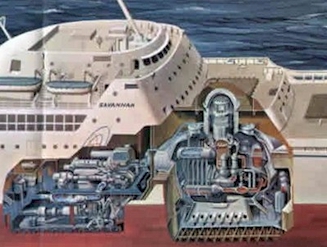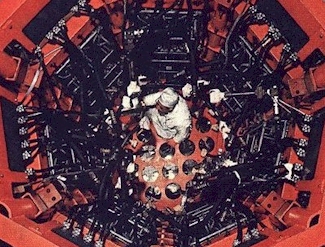- The Vitruvian Plant: Powering the Future #10-2284
-
Background
History of Nuclear Energy Nuclear Agencies and Regulations Nuclear Power in the Public Eye Economics of Nuclear Energy Radioactivity Basics Nuclear Reactor Basics Current Reactor Designs Processing Radioactive Materials Remote Handling Uses of Radiation Archimedes Filter Technology New Generation Reactors
- Components
- Project
Component Two
Identify two companies and one product produced by each company that directly relate to the NCT technical application your team has selected.
The Babcock and Wilcox Company was awarded a contract totaling approximately $2.0 billion to manufacture naval nuclear power systems for submarines and air force carriers. The work will take place over a 10-year window of time, commensing in January 2011. B&W has its corporate headquarters in Charlotte, North Carolina. The company is a leader in clean energy technology and services and has locations worldwide, employing over 12,000 people. B&W has designed and manufactured nuclear heat exchangers, steam generators, pressurized reactor vessels, as well as dry storage containers for over 40 years.
The company has a long history with small reactors, having built components for the USS Nautilus (1955) and the onboard reactor for the NS Savannah (1961). Babcock and Wilcox are currently developing a scalable, small nuclear reactor called the mPower. For more information see our background page on new generation reactors.

|

|
| Images courtesy of Siemens and Westinghouse | |
Westinghouse fuel manufacturing locations include the Windsor Fuel Components Facility (Windsor, Connecticut, USA), Western Zirconium Plant (Ogden, Utah, USA), Specialty Metals Plant (Blairsville, Pennsylvania, USA), Core Engineering (Monroeville, Pennsylvania, USA), Columbia Site (Columbia, South Carolina, USA)
Westinghouse and Siemens are directly related to our product since Westinghouse Electric Company provides fuel, services, technology, plant design, and equipment for the commercial nuclear electric power industry. Westinghouse has developed nuclear fuel rods for the AGR, BRR, CE, and PWR reactors and is in the process of creating fuel for NGR, or next generation reactors.
Because of the importance of the Archimedes Filter Plant in our product we would like to include a third company, FAR-TECH, Inc.
FAR-TECH, Inc. was founded in 1994 by Dr. J. S. Kim, is located in San Diego. They have received multiple Small Business Innovative Research grants from the US Department of Energy and Department of Defence. FAR-TECH specializes in modeling/simulation, data analysis, custom hardware/software design, and validation tests while their R&D department specializes in topics related to particle accelerators and plasma/fusion. Their research in the Archimedes Filter Technology is crucial to our product. They company has collaborated with numerous organizations: including, the Argonne National Laboratory, DIII-D National Fusion Facility, the Lawrence Livermore National Laboartory and the Lawrence Berkeley National Laboratory.
Identify one professional association or trade organization associated with the
products your team identified.
Include:
 its name,
its name,
 description of its mission, and
description of its mission, and
 number of people/companies involved.
number of people/companies involved.
IEEE has as their mission
statement:
 IEEE consists
of 38 societies that specialize in various areas of technology, with one being the
Nuclear and Plasma Sciences Society
(NPSS). The Nuclear and Plasma Sciences Society was
established in 1949, it has since evolved into a cluster of nine sub-committees
that carry out the technical running of their organization. Many of these directly
relate to the nuclear industry: Standards for Nuclear Instruments and Detectors,
Radiation Instrumentation, and Computer Applications in Nuclear and Plasma Science.
IEEE's Nuclear and Plasma Sciences Society serves as a medium for information distribution
on topics relevant to its over 3000 engineers and scientists. Information updates
are accomplished through
scheduling a multiple conferences, journals, and a series of newsletters
published throughout the year. On
November 7-11, 2010, there will be a conference in Las Vegas, NV, addressing
Nuclear Plant Instrumentation, Control, and Human Machine Interface Technologies.
IEEE consists
of 38 societies that specialize in various areas of technology, with one being the
Nuclear and Plasma Sciences Society
(NPSS). The Nuclear and Plasma Sciences Society was
established in 1949, it has since evolved into a cluster of nine sub-committees
that carry out the technical running of their organization. Many of these directly
relate to the nuclear industry: Standards for Nuclear Instruments and Detectors,
Radiation Instrumentation, and Computer Applications in Nuclear and Plasma Science.
IEEE's Nuclear and Plasma Sciences Society serves as a medium for information distribution
on topics relevant to its over 3000 engineers and scientists. Information updates
are accomplished through
scheduling a multiple conferences, journals, and a series of newsletters
published throughout the year. On
November 7-11, 2010, there will be a conference in Las Vegas, NV, addressing
Nuclear Plant Instrumentation, Control, and Human Machine Interface Technologies.
Applicable NPSS fields of interest related to our project include: nuclear instrumentation development for reactor systems; effects of radiation on materials, components, and systems; and applications of radiation and nuclear energy to other than utility power generation.
IEEE's core purpose is to foster technological innovation and excellence for the benefit of humanity.
 IEEE consists
of 38 societies that specialize in various areas of technology, with one being the
Nuclear and Plasma Sciences Society
(NPSS). The Nuclear and Plasma Sciences Society was
established in 1949, it has since evolved into a cluster of nine sub-committees
that carry out the technical running of their organization. Many of these directly
relate to the nuclear industry: Standards for Nuclear Instruments and Detectors,
Radiation Instrumentation, and Computer Applications in Nuclear and Plasma Science.
IEEE's Nuclear and Plasma Sciences Society serves as a medium for information distribution
on topics relevant to its over 3000 engineers and scientists. Information updates
are accomplished through
scheduling a multiple conferences, journals, and a series of newsletters
published throughout the year. On
November 7-11, 2010, there will be a conference in Las Vegas, NV, addressing
Nuclear Plant Instrumentation, Control, and Human Machine Interface Technologies.
IEEE consists
of 38 societies that specialize in various areas of technology, with one being the
Nuclear and Plasma Sciences Society
(NPSS). The Nuclear and Plasma Sciences Society was
established in 1949, it has since evolved into a cluster of nine sub-committees
that carry out the technical running of their organization. Many of these directly
relate to the nuclear industry: Standards for Nuclear Instruments and Detectors,
Radiation Instrumentation, and Computer Applications in Nuclear and Plasma Science.
IEEE's Nuclear and Plasma Sciences Society serves as a medium for information distribution
on topics relevant to its over 3000 engineers and scientists. Information updates
are accomplished through
scheduling a multiple conferences, journals, and a series of newsletters
published throughout the year. On
November 7-11, 2010, there will be a conference in Las Vegas, NV, addressing
Nuclear Plant Instrumentation, Control, and Human Machine Interface Technologies.
Applicable NPSS fields of interest related to our project include: nuclear instrumentation development for reactor systems; effects of radiation on materials, components, and systems; and applications of radiation and nuclear energy to other than utility power generation.
Propose and describe a new product or new process based on your team's NCT technical application.
Our product is a closed-loop designed to incorporate an
Archimedes Filter Plant as a means of reprocessing spent nuclear fuel for use as
usable fuel in a Next Generation Nuclear Reactor. Using remote handling methods,
our product represents a "Nuclear Community" that reduces transportation of nuclear
materials as well as increasing the saftey and security of all sections of the system.
Via the Internet, locate a company that might be able to manufacture your team's proposed product. Send the company an e-mail asking that someone in the company evaluate the product your team proposed. If your team is not able to obtain a response to your inquiry, provide on your website an example of the e-mail request you sent and the names of manufacturers to whom you sent the request.
During the month of February after discussing our product with our technical advisor,
Mr. Michael Friend, we sent emails to two companies who manufactured components
for our product. One company had built a prototype of an Archimedes Plasma Mass
Filter and we asked their opinion on setting up a system of multiple facilities
in series to successively separate radioisotopes of decreasing mass from a sample
of spent nuclear fuel. The second company we wrote had obtained a patent for developing
a traveling wave reactor. We asked them to describe the size and composition of
the fuel pellets used in their reactor. Neither of these companies answered our
requests.
At the end of project, we received this letter from our techical adviser. The team was elated when they read his assessment of our work.
At the end of project, we received this letter from our techical adviser. The team was elated when they read his assessment of our work.
7th International Meeting on NPIC & HMIT 2010
http://meetings.ans.org/npic-hmit/Welcome.html
About IEE Nuclear and Plamsa Sciences Society
http://ewh.ieee.org/soc/nps/about-npss.html
About IEEE
http://www.ieee.org/about/index.html
B&W Awarded $2.0 Billion Naval Nuclear Reactor Components Contract
http://www.babcock.com/news_and_events/2011/20110113a.html
Columbia Site
http://www.westinghousenuclear.com/ProductLines/Nuclear_Fuel/columbia_site.shtm
Commercial Nuclear Plant Components: Reactor Vessels
http://www.babcock.com/products/commercial_nuclear_plant_components/reactor_vessels.html
Commercial Nuclear Plant Components: Spent Fuel Dry Storage Containers
http://www.babcock.com/products/commercial_nuclear_plant_components/storage_containers.html
Commercial Nuclear Plant Components: Steam Generators
http://www.babcock.com/products/commercial_nuclear_plant_components/steam_generators.html
Conferences of the IEEE Nuclear and Plasma Sciences Society
http://ewh.ieee.org/soc/nps/conferences.html
Core Engineering
http://www.westinghousenuclear.com/ProductLines/Nuclear_Fuel/nf_core_engineering.shtm
FAR-TECH
http://www.far-tech.com/index.html
History - Siemens Global Website
http://www.siemens.com/about/en/history.htm
IEEE Mission & Vision
http://www.ieee.org/about/vision_mission.html
Modular Nuclear Reactors
http://www.babcock.com/products/modular_nuclear/
Nuclear and Plasma Sciences Society
http://ewh.ieee.org/soc/nps/
Siemens USA
http://www.usa.siemens.com/entry/en/index.htm?stc=usccc020192
Specialty Metals Plant
http://www.westinghousenuclear.com/ProductLines/Nuclear_Fuel/specialty_metals_plant.shtm
The Babcock & Wilcox Company
http://www.babcock.com/
The History of Siemens – From Workshop to Global Player
http://www.siemens.com/about/en/history.htm
The World’s First Nuclear Merchant Ship – NS Savannah
http://gcaptain.com/the-worlds-first-nuclear-merchant-ship-ns-savannah?565
Western Zirconium Plant
http://www.westinghousenuclear.com/ProductLines/Nuclear_Fuel/western_zirconium_plant.shtm
Westinghouse AP1000: On schedule for 2013
http://www.westinghousenuclear.com/docs/AP1000Ad.pdf
Westinghouse Announces its Small Modular Reactor (SMR) Design
http://westinghousenuclear.mediaroom.com/index.php?s=43&item=262
Westinghouse Electric Company, LLC
http://www.westinghousenuclear.com/
Windsor Fuel Components Facility
http://www.westinghousenuclear.com/ProductLines/Nuclear_Fuel/windsor_components_plant.shtm





